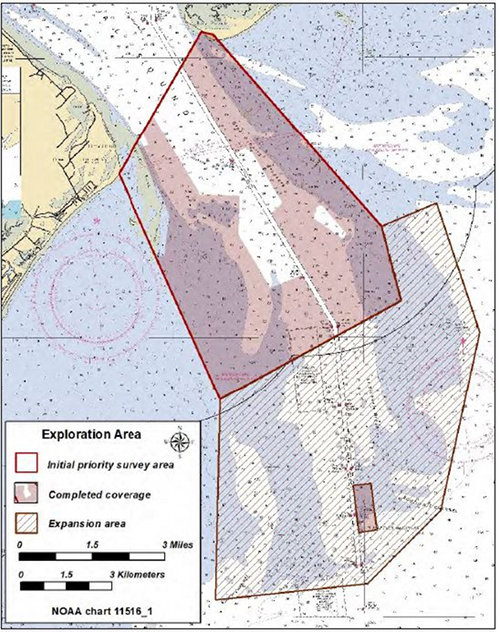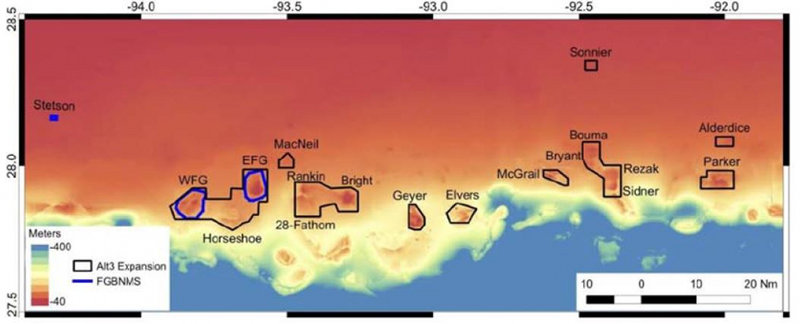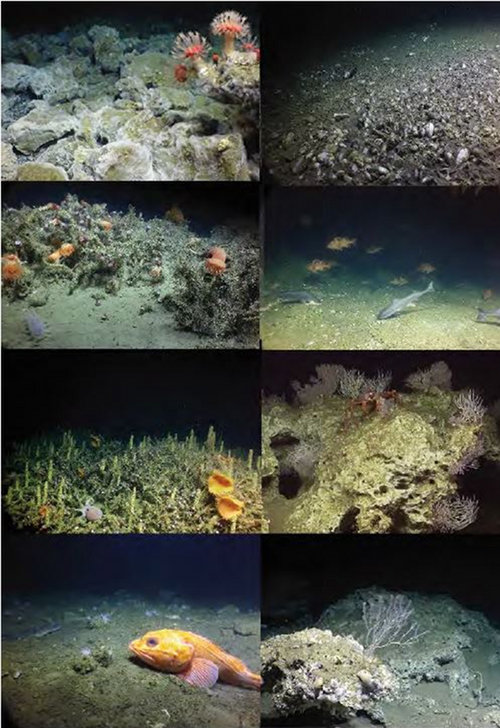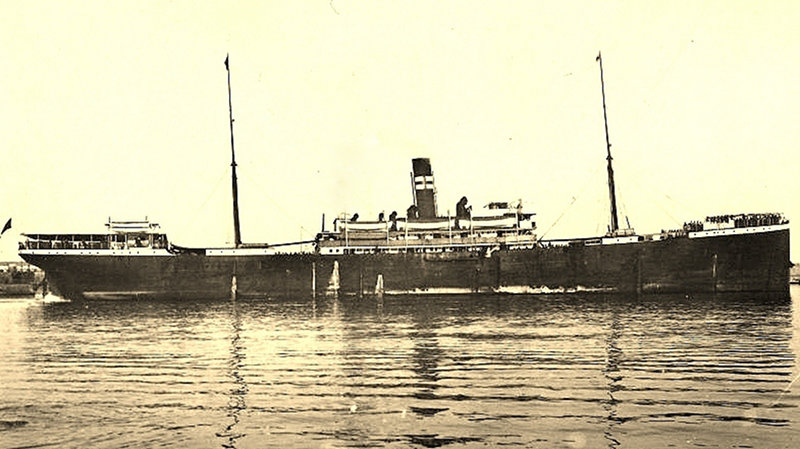Fiscal Year 2019 NOAA Office of Ocean Exploration and Research
Federal Funding Opportunity Grants
September 25, 2019
Through the Ocean Exploration Fiscal Year (FY) 2019 Funding Opportunity, the NOAA Office of Ocean Exploration and Research (OER) selected eight projects for financial support totaling approximately $3.3 million. For the FY 2019 competition, OER solicited proposals for ocean exploration to address knowledge gaps and support growth in the nation’s Blue Economy. Priorities were focused on discovering organisms with biopharmaceutical or biotechnical potential, gathering baseline information on areas of potential ocean energy development or critical mineral extraction, and investigating shipwrecks and submerged cultural resources. The supported projects are described below.
Bioprospecting for Industrial Enzymes and Drug Lead Compounds in an Ancient Submarine Forest
Principal Investigator: Daniel L. Distel, Northeastern University
Dates: September-December 2019 and August-December 2020 (15 days)
As demand grows for discovery of novel industrial enzymes and new medicines, researchers are increasingly turning toward marine sources. To that end, this research team will systematically explore the diversity and economic potential of a submerged prehistoric bald cypress forest off the coast of Alabama. They aim to describe this unexplored ecosystem and assess the potential of this biodiverse microbiome as a target for the directed discovery of biomolecules of high biopharmaceutical and biotechnological value. Their emphasis will be on bacterial species associated with wood-eating teredinid bivalves (or “shipworms”).
The research team will collect, identify, georeference, voucher, and subsample these species for microbial cultivation and genomic and metagenomic analyses. In addition, they will perform biochemical and growth inhibition assays and bioinformatic analyses to identify analgesic and antimicrobial compounds and hydrolytic enzymes capable of degrading the components of wood. Such enzymes have broad application in production of pulp, paper, textiles, food, animal feeds, fine chemicals, and renewable fuels.
This exploration project will lay the groundwork for understanding and exploiting similar communities as sources of new compounds for medicine and biotechnology. To enhance the value of their exploratory efforts, the researchers aim to create effective tools and resources to support future discovery and education.

Example of the type of small autonomous underwater vehicle that will be used for this project. Image courtesy of Bonaire 2008: Exploring Coral Reef Sustainability with New Technologies. Download image (jpg, 94 KB).
Benthic Communities and Their Biopharmaceutical Potential Across Mineral-rich Biomes off Southern California
Principal Investigators: Lisa A. Levin and Paul Jensen, Scripps Institution of Oceanography, University of California San Diego.
Dates: Fall 2019 (4 days)
Demand for access to deepwater mineral resources is growing. This growth is accompanied by the need for environmental management as exploitation of minerals may come at a cost to other ecosystem functions and services. To help inform resource use decisions, the research team will generate baseline information for two poorly explored, mineral-rich ecosystems containing phosphorites and iron-manganese crusts (two resources of considerable economic interest) in the Southern California Borderland (SCB). Through extensive video, still photos, and sample collection, they will characterize fish and benthic megafauna and macrofauna supported by these habitats, including infauna and invertebrates attached to mineral surfaces. They will also characterize the associated microbial communities with sediment and mineral surfaces as well as invertebrate-associated microbes.
In addition, the team will explore the natural product biosynthetic potential of these sites. These explorations will include state-of-the-art metagenomic and metabolomic techniques and will test extracts generated from sponges, corals, and other SCB marine invertebrates for pharmaceutically relevant biological activities. Their results will raise awareness of the biotic diversity and biopharmaceutical potential in the borderland and provide critical information needed for future decision making and impact assessments should these deep-sea habitats be considered for development.

Sampling sites in the Southern California Borderland. Image courtesy of Lisa Levin et al. Download larger version (jpg, 131 KB).
Shoals and Shipwrecks: Archaeological Explorations off Port Royal Sound, South Carolina
Principal Investigator: James D. Spirek, South Carolina Institute of Archaeology and Anthropology, University of South Carolina.
Dates: Fall 2019-Spring 2021 (100 days)
Historical research suggests that at least 40 shipwrecks lay near or on the shoals fringing the entrance channel to Port Royal Sound, South Carolina. These shipwrecks include the French corsair, Le Prince; a British warship, the HMS Colibri; and the Union merchant bark Marcia. The research team seeks to continue and expand efforts to locate shipwrecks such as these and other structures, sites, and objects of archaeological and historical significance in the area. With this award, they aim to support preservation efforts by recording and identifying their discoveries, enabling more in depth investigations and mitigation in the future.
The team will use advanced marine remote-sensing technology and visual inspections in the search area, which includes both state and federal waters. They will complement this work with historical research to develop the maritime historical context of the region.
In addition to filling in knowledge gaps regarding the region’s historical maritime activities (e.g., transport, trade, and warfare), findings from this project will also be used to inform state and federal seafloor management decisions. Resource managers will be able to use this information to balance uses and minimize conflicts between the preservation of these archaeological remnants and competing interests in the area’s mineral resources (e.g., beach quality sand needed to rebuild local beaches).

Exploration area encompassing shoals at entrance to Port Royal Sound. Image courtesy of James D. Spirek et al. Download larger version (jpg, 133 KB).
The Search for Norlindo—The First World War II Casualty in the Gulf of Mexico
Principal Investigator: Arne-R. Diercks, University of Southern Mississippi.
Dates: March-June 2020 (16 days)
On May 4, 1942, the U.S. freighter Norlindo became the first ship lost to Germany’s World War II campaign in the Gulf of Mexico. The research team plans to locate, explore, and document the wreckage of this significant archaeological resource in an underexplored area of the eastern Gulf where little is known about the nature and preservation status of World War II casualties. By doing so, they will shed light on the Gulf’s unique history and inform the ship’s status as a potential environmental hazard and its eligibility for listing on the National Register of Historic Places.
The research team will conduct a high-resolution acoustic survey in the area of Norlindo’s last known position, about 80 miles northwest of the Dry Tortugas islands, collecting bathymetric and water column data. They will also produce a benthic habitat map that incorporates microbiological data acquired by sampling water, sediment, and wreck debris. This project will improve understanding about how steel historic shipwrecks from World War II shape seafloor biogeography and biodiversity.
In addition, the team will develop a project-focused, one-week Gulf Exploration Camp designed to engage high school students from across the country in the maritime history and ecology of the Gulf of Mexico.

One of the few existing historical photos of the Norlindo (previously named Volusia) in the early 1930s. Image courtesy of the Historical Collections of the Great Lakes, Bowling Green State University. Download image (jpg, 40 KB).
Exploring the Blue Economy Biotechnology Potential of Deepwater Habitats
Principal Investigator: Amy E. Wright, Harbor Branch Oceanographic Institute, Florida Atlantic University.
Dates: Spring 2020 (14 days)
Natural products produced by marine plants, invertebrates, and microbes are increasingly relevant in the field of biopharmaceuticals. To further the work in this area, the research team will explore deepwater habitats adjacent to the Flower Garden Banks National Marine Sanctuary in the Gulf of Mexico with the goal of identifying marine organisms that contain novel bioactive natural products that can be translated into useful pharmaceutical products or biomedical research tools.
The research team will use a remotely operated vehicle (ROV) to collect benthic specimens with high potential for biopharmaceutical discovery, including sponges, octocorals, black corals, algae, and select scleractinian corals. They will subsample the specimens for taxonomic reference samples, genetic analyses, and biomedical analyses. The researchers will also use the ROV to document the habitats they explore and the animals they collect with video and still photography.
In addition, to support collaboration and future research, the team will develop resources for long-term use in biopharmaceutical and other Blue Economy discovery efforts. These resources include a frozen specimen library, an enriched chemical library, a microbial culture library, a DNA library, and a bank of cryopreserved sponge cultures.

Map of the Flower Garden Banks showing the various banks that will be explored (outside of the marine sanctuary). Image courtesy of Santiago Herrera, Lehigh University. Download larger version (jpg, 56 KB).
Gradients of Blue Economic Resources in and Around Deep-sea Methane Seeps
Principal Investigator: Andrew Thurber, Oregon State University.
Dates: July 1-7, 2020 (7 days)
Once thought to be rare, scientists have identified more than 2,500 methane seeps on the U.S. Cascadia margin off the Oregon and Washington coasts. Only a handful of these have been studied. To expand our knowledge about the role of methane seeps in the ocean ecosystem, the resources they host, and the economic potential of these resources, the research team will combine a suite of established and emerging technologies to explore recently discovered deep-sea methane seeps within this region.
To do so, the team will sample background habitats and seeps and undertake a gradient analysis to better quantify the footprint of seeps, the resources they provide, and their interactions with the broader ecosystem of the U.S. Exclusive Economic Zone. They will analyze the samples collected for various resources, including biopharmaceutical or biotechnological compounds and rare earth elements.
Through this work, the team hopes to inform economic growth and sustainable marine resource management as they relate to both emerging (e.g., hydrate, oil and gas, and mineral mining) and existing (e.g., fishing) uses. This includes providing resource managers with more information about how emerging resource extraction scenarios might affect regional ecosystem services (e.g., fisheries production).

Examples of the diversity of habitats and fauna at methane seeps along the Cascadia margin. Image courtesy of Ocean Exploration Trust. Download image (jpg, 112 KB).
Florida Keys National Marine Sanctuary Quicksands Archaeological Survey
Principal Investigator: Matthew Lawrence, NOAA/Office of National Marine Sanctuaries.
Dates: July-August 2020 (16 days)
Over the past five centuries, many vessels have been lost among the shoals and shallow reefs of the “Quicksands,” an area between the Marquesas Keys and the Dry Tortugas in the Florida Keys National Marine Sanctuary (FKNMS). Despite its high potential for historically significant shipwrecks and the numerous commercial treasure hunting activities taking place there, the Quicksands area has not been systematically explored, and very little is known about its archaeological resources. This team of archaeologists and ecologists plans to conduct a maritime archaeological mapping and diving survey to locate and document archaeological sites and identify associated biological resources.
The research team will gather baseline ecological data about marine life in, on, and in the immediate surroundings of their discoveries. This will enable them to assess the impact of artificial hard-bottom structures in a dynamic marine environment where there are few natural hard-bottom habitats. It will also help them better understand the area in the context of its particular conditions and its location between the highly protected reefs of the Dry Tortugas and the rest of the Florida reef tract.
FKNMS managers will be able to use project results to support future management decisions and studies of the area’s archaeological and biological resources. This includes making decisions about treasure salvage permitting and preventing related environmental impacts.

Transatlantic passenger steamship Valbanera, one of this project’s primary targets. Image courtesy of Wikimedia Commons. Download image (jpg, 96 KB).
Wimble Shoals: An Exploration and Characterization of Submerged Cultural and Sediment Resources
Principal Investigator: Joseph Hoyt, NOAA's Monitor National Marine Sanctuary.
Dates: TBD (60 days)
North Carolina is notorious for its dangerous shoals. Among them is Wimble Shoals, off northern Hatteras Island on North Carolina’s Outer Banks, which contains important cultural resources and habitats. The research team will survey the shoals, both above and below the seafloor, to search for maritime heritage resources.
Several historic shipwrecks are believed to be on or within the sediments of Wimble Shoals. One of these shipwrecks is the British tanker SS Mirlo, which was sunk by a German U-boat during World War I. A primary target for this expedition, the Mirlo is important to understanding World War I in the region, and the rescue of personnel from the Mirlo by the crew of the Chicamacomico Lifesaving Station is of special significance to the history of the U.S. Coast Guard and the U.S. Lifesaving Service. Discovery of the Mirlo would also help inform a proposed expansion of the Monitor National Marine Sanctuary.
The team will also study the shoals’ natural resources, both the biological resources (on the seafloor, in the water column, and on and around the shipwrecks) and the sediments. The shoals have been identified as a potential source of sand for beach nourishment projects. The results of this expedition will provide resource managers with information about how these sediments impact the shoals’ cultural and living resources.

An example of the photogrammetric modeling that will be used to image shipwreck sites. Image courtesy of Monitor National Marine Sanctuary, J. Hoyt. Download image (jpg, 104 KB).